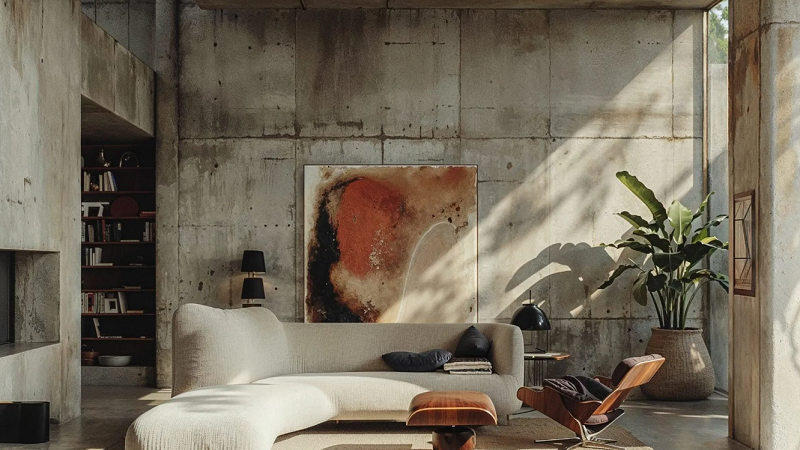Minimalist brutalist interior design is an emerging trend that blends simplicity with raw, unpolished beauty. It captures the essence of functionality while maintaining a bold aesthetic. This guide explores how minimalist brutalist interior design combines clean lines, neutral tones, and raw materials to create timeless and sophisticated spaces.
Key Characteristics of Minimalist Brutalist Interior Design
Simplicity and Functionality Minimalist brutalist interior design emphasizes functionality. Every element in the space serves a purpose, with no room for unnecessary ornamentation. The focus lies on essential features that highlight the structure and practicality of the design.
Raw Materials Raw materials such as concrete, steel, exposed brick, and wood play a central role in brutalist interiors. These materials reflect an industrial aesthetic that aligns perfectly with the minimalist ethos.
Neutral Color Palette The color scheme is deliberately subdued, featuring shades of gray, black, white, and earthy tones. This palette enhances the raw textures of the materials and creates a harmonious environment.
Clean Lines and Open Spaces Minimalist brutalist designs often showcase clean, geometric lines. Open layouts further emphasize the spaciousness and allow the materials and textures to take center stage.
Materials and Textures in Brutalist Interiors
Concrete as a Dominant Element Concrete is the backbone of brutalist design. From floors to walls and even furniture, its versatility and raw appeal make it an indispensable material.
Steel and Metal Accents Steel and metal are used to add an industrial edge. Light fixtures, furniture frames, and structural details in metal provide a sleek yet rugged look.
Wood for Warmth While brutalist interiors lean toward industrial aesthetics, wood is often incorporated to balance the starkness and add warmth. Wooden furniture or flooring softens the overall look.
Textured Elements Textures are key to creating depth in brutalist interiors. The rough finish of concrete walls or the natural imperfections of wood surfaces add character to the space.
Designing a Minimalist Brutalist Space
Choosing the Right Space Minimalist brutalist interiors work best in spaces with high ceilings and large windows. The architecture should complement the design, allowing natural light to accentuate the raw materials.
Lighting Considerations Lighting plays a crucial role in enhancing the aesthetic. Opt for minimalistic light fixtures in materials like metal or glass. Natural light should be maximized to highlight the textures and create a dynamic interplay of shadows.
Furniture Selection Furniture in minimalist brutalist interiors should be bold and functional. Pieces with clean lines and sturdy materials like wood, concrete, or metal align with the design philosophy.
Decor Choices Decor is kept minimal yet purposeful. Choose monochromatic artwork, industrial-style lamps, or greenery to bring life to the space without overwhelming it. Each decorative element should align with the overall theme.
Benefits of Minimalist Brutalist Interior Design
Timeless Aesthetic Minimalist brutalist interiors have a timeless appeal, blending modernity with classic design principles. Their understated elegance ensures they remain relevant for years.
Cost-Efficiency Using raw materials like concrete and steel can be cost-effective, especially for large-scale projects. Their durability also ensures a long lifespan, reducing the need for frequent replacements.
Sustainability Brutalist design often incorporates eco-friendly materials and practices. Using durable, long-lasting materials minimizes environmental impact.
Stress-Free Living The uncluttered nature of minimalist brutalist interiors promotes mental clarity and relaxation. The simplicity of the design encourages a stress-free and focused lifestyle.
Challenges and How to Overcome Them
Cold and Industrial Feel. A common critique of brutalist interiors is that they can feel cold or unwelcoming. To counteract this, incorporate textiles such as rugs, cushions, or curtains in neutral tones. Adding greenery can also soften the industrial vibe.
Balancing Simplicity with Personality. While minimalist brutalist interiors prioritize simplicity, personal touches are essential. Incorporate meaningful decor items, such as a piece of art or a vintage object, to reflect your personality without cluttering the space.
Space-Specific Limitations: Not all spaces are conducive to brutalist design. For smaller areas, focus on lighter shades and use mirrors to create an illusion of space. Compact furniture and multi-functional elements can also help.
Inspiring Examples of Minimalist Brutalist Interiors
Residential Spaces :Brutalist interiors in homes often feature open-plan living areas with concrete floors, steel-framed furniture, and large windows. Subtle additions like wooden dining tables or potted plants balance the raw aesthetic.
Commercial Spaces, Office,s and retail spaces embrace brutalist design to create modern, professional environments. Exposed ceilings, concrete walls, and minimalistic lighting fixtures define these interiors.
Public Spaces: Brutalist elements are increasingly seen in cafes, libraries, and art galleries. These spaces utilize raw materials and open layouts to foster creativity and interaction.
Conclusion
Minimalist brutalist interior design is a harmonious blend of simplicity and raw aesthetics. This design style creates timeless and functional spaces by focusing on essential elements and embracing the beauty of raw materials. Whether in homes or commercial settings, minimalist brutalist interiors offer a unique way to express modern sophistication. Explore this bold design trend and transform your space into a haven of elegance.

